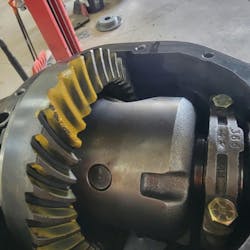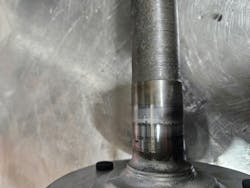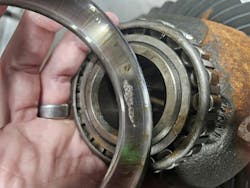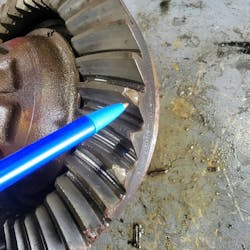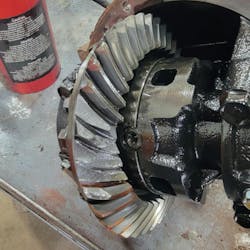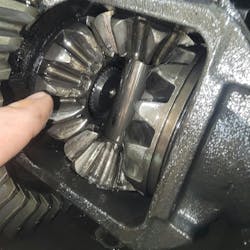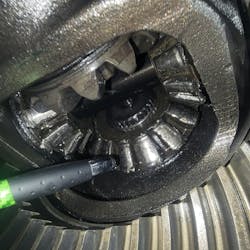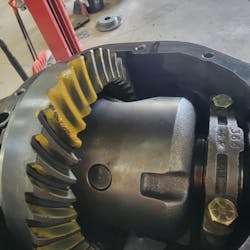Ask any technician, and they will tell you that the bane of their existence is the elusive noise, vibration, harshness (NVH) complaint. Those nuisance concerns that all too often turn into a nightmare game on the telephone where the customer tries to articulate their concern to a service writer, who in turn tries to explain those same concerns to the technician. Driveline noise falls squarely into this category. Perhaps not as intermittent as that under-dash squeak that seems to only happen on a Tuesday morning between 7:00 a.m. and 7:03 a.m. during a waxing crescent moon, but driveline noises can drive technicians bonkers if they don’t understand what they are hearing.
When one stops and thinks about all the rotating mass in the driveline of any given vehicle, it’s no wonder that driveline noise complaints are one of the more common noise-type jobs a technician sees. Within the driveline of a vehicle, you have a few main categories: transmission, transfer case/PTU, driveshaft, differentials, axles, and wheel end. Now every ICE vehicle on the road has these components to some varying degree, and they all present their own challenges when diagnosing noise complaints. But for this article I want to concentrate and dive into the differential, axle, and wheel end side of the equation.
Understanding the Basics
The differential’s key role is to allow the drive wheels to rotate at different speeds while transmitting power from the engine. This function is essential for smooth and stable vehicle operation, especially during cornering. As a vehicle turns a corner, the wheels on the outside of the turn need to spin faster than those on the inside of that turn. Because of this, the drive wheels of the vehicle need to be able to spin independently of one another while still providing power to maintain traction and reduce tire wear. This is where the differential steps in.
If you think about a traditional axle assembly found in the rear of a pickup truck, contained within you will find, among other things, the differential carrier. Let’s say this is an open differential. So, no clutches, governor-operated lockers, torsions, etc. Contained within the carrier you will find side gears that spline directly with the axle shafts, and spider gears (also known as satellite gears) that ride on a pin that meshes with the side gears. These gears take the rotational energy from the driveshaft and redirect it to the axles. These gear sets allow the rear tires of this truck to rotate at different speeds while going around corners.
Many of you have probably operated a vehicle that has a locked differential, and I don’t mean a mechanical locker that can ratchet and unlock in turns, but a solid unit, meaning both drive tires will spin at the same rate. It's very common in performance and off-road applications. People will install a full spool in place of the carrier, or a mini spool that replaces the side and pinion gears on an open carrier. Or, if they are on a real bare bones budget, they may even break out the MIG welder and build what’s commonly referred to a “Lincoln locker” where one simply welds the spider gears and side gears in place. Any of the afore-mentioned options prevent any differential action, and they apply power to both tires equally. The tradeoff in this situation is turning radius, tire wear, and extreme stress on other components of the driveline, like the axles. Differentials, regardless of design, are an important part of the equation when it comes to vehicle driveability and overall longevity of the driveline, but with all that componentry comes the added opportunity for items to wear, become damaged, and in turn make noise.
A differential consists of a network of components that work together to perform power transfer and differential action. This network of intricate componentry is susceptible to wear due to its heavy usage, which often makes itself known by noise and vibration heard and felt by the driver. Again, as we did earlier let’s start out talking about the basic open carrier. The rear axle assembly in our imaginary pickup truck will be connected to the driveshaft via a flange. That flange will be splined to a pinion gear. The pinion gear will mesh with and drive a ring gear that is bolted to a differential carrier housing. That differential carrier housing will contain spider gears that ride on a pin that is incorporated into the housing assembly and that mesh with side gears that are splined to both axle shafts. The pinion gear, the carrier assembly, and axle shafts are all supported by bearings. So, as you can see there is a lot of opportunity for wear and noise to develop. The challenge is to be able to identify some of these noises and start to develop a preliminary diagnosis while test driving the vehicle —before you need to start tearing anything apart.
It's All About Having a Plan
When it comes to noise diagnostics, and what the root cause is, there is never a silver bullet, especially when dealing with the vehicle’s driveline. But, with experience, a technician can develop a mental diagnostic flow chart to follow depending on when or how the noise presents itself.
Start with the most basic of noises, a growling or whirring from the wheel end. Most technicians are familiar with the telltale sound of a failing wheel bearing or axle bearing. While serviceable tapered roller bearings are found in some older applications, modern sealed unit bearings are found front and rear of many applications, as well as modern full and semi-floating truck axle bearings make wheel bearing noise diagnostics fairly straightforward. Pitch changes as vehicle weight is shifted and the suspension is loaded and unloaded make finding the problem a straight-forward affair.
The pitch change that gets louder as you load the bearing, and quieter as you unload is not only a clear indication of a problem, but also where the problem is located. Galling, pitting, or wear located on the bearing rollers, the bearing race, or as you can see in Figure 1, the axle shaft itself, will generally present noise that will change with loading.
Where things start to get a little trickier is when we move farther into the axle or transaxle assembly. Remember the differential carrier? That carrier assembly is going to ride in the housing on two carrier bearings. These carrier bearings will typically present themselves as noise that starts above about 20 mph and generally will continue to increase in intensity as vehicle speed increases. As torque is applied to the ring gear via the pinion, it loads those carrier bearings. Just like a loaded wheel bearing, these will present themselves as grinding or growling noises typically on acceleration above that 20-30mph mark. Like the wheel bearing, galled or otherwise failing carrier bearings and damaged races (Figure 2) are easily identified when the technician learns what to listen for.
Moving forward from the carrier you will find the pinion gear. Just like the carrier, the pinion is supported by two bearings, an inner and outer. And just like a carrier bearing, these generally are a tapered roller. But how these bearings react under load when worn when compared to the carrier bearings, at least in my experience, is a little different. When the initial setup of a ring and pinion gear set is performed, the pinion bearing preload is set. Often, pinion preload is set and maintained by a collapsable sleeve known as a “crush sleeve.” While a solid spacer and shims are used in some larger or performance applications, the crush sleeve is the most often used component to set and maintain this extremely important specification. The reasoning behind it is simple. It is less expensive and faster to set up. The downside is, over time, pinion bearing preload can be lost due to wear or abuse. Just like in a wheel bearing that uses a tapered roller cone and cup, proper bearing preload is everything. Too little preload is just as detrimental to a tapered roller bearing as too much, and when damage to either pinion bearing’s cup or cone occurs, noise is often the result.
Pinion bearing noise is the leading misdiagnosed noise within the rear differential. Typically, when the pinion bearings lose their preload or become damaged, the result is a whirring or whine most often heard on deceleration. This is often incorrectly attributed to a worn ring and pinion gearset. When load is applied to the pinion through the driveline from the engine/transmission under acceleration and cruise, the bearings — even when preload is incorrect or there is wear present in the cone or cup — often will operate quietly. The load on the pinion and its bearings will often mask any minor noise because it shifts where the pressure is placed on the pinion bearings themselves. Under coast and deceleration, when the pinion is driven by the wheels and both contact and load on the pinion bearings changes, often that is when the noise will present itself. Again, it’s been my experience that this noise is incorrectly attributed to a worn or incorrectly set up ring and pinion. Keep in mind, while technicians should be making preliminary deductions while test driving the vehicle, it’s then incredibly important to follow up those hypotheses with further inspection once back in the bay.
Rhythmic clunking, grinding, whirring, and what is often described as a “zing,” are often attributed to the gearset itself. Wear, abuse, incorrect setup/break in, and material failure can all lead to noise complaints that stem from ring and pinion gears. Insufficient lubrication can prematurely wear a gearset, greatly changing the way the pinion and ring gear contact one another, leading to harmonics. Customers who put off that leaking pinion or axle seal replacement and don’t consistently check their gear oil level will eventually find themselves with a much more expensive repair.
Fluid contamination due to water intrusion is another common cause of gearset (and bearing) failure. Anytime the driveline is submerged, especially above the vent, all those components should be serviced. Another common driveline noise complaint is “clunking.” A clunking sound that is consistent when moving forward and in reverse in a turn or a straight line is a tell-tale sign of chipped (Figure 3) or sheered teeth on the ring or pinion gears (Figure 4). Overstressing the gearset, from things like oversized tires, is the root cause of failures like this. This is compounded by the ability to make significant power increases relatively inexpensively on many of the modern engine platforms like LS/LT, Hemi, and Coyote. Enthusiasts quickly find that proverbial “fusible link” in their drivetrain as soon as they start making power and finding traction, and often a failure with the differential and/or axles shafts themselves occurs.
Getting Even Deeper
Within the differential carrier case and internals, you also have ample opportunity for noise. Regardless if you have a standard open differential, a limited slip like an Eaton Posi, an Auburn Grip-N-Loc, or a locker like the Gov-Loc, mechanical failures due to material failure, abuse, and lack of or improper maintenance are common. Remember, the main purpose of the differential is not only the transfer of power, but to allow the wheels to spin independently when navigating turns. Unusual noise or vibration in a turn while there is a difference in wheel speed between the inner and outer wheels most likely can be attributed to an issue within the differential carrier itself.
As we have stated, most carriers contain spider and side gears that allow this differential action to take place. Clunks and gear noise are not unlike a broken ring and pinion, but when they can only be heard while turning, that's a clear indication of damage to those spider or side gearsets. Broken teeth due to abuse or material failure (Figure 5) and worn or pitted gears due to high mileage and/or lack of maintenance are the top causes of these noises. In instances of complete internal failure, the vehicle will be unable to transfer power to the drive wheels at all. Many high school-aged drivers thrill themselves while discovering the joy of converting rubber into smoke, only to quickly have that joy dashed by the unscheduled rapid disassembly of the internal components of their rear differential due to the extreme heat that is produced, especially with an open carrier (Figure 6).
Chatter is also a common complaint with customers who own vehicles that use clutch or cone style limited slip differentials. Improper differential service procedures are often at the root of these complaints. Often OE and aftermarket carriers require specific fluids and friction modifiers to ensure that the clutch disks or cones found within these differentials can function correctly and smoothly. While most technicians know that friction modifier is generally required to be added to the differential when a gear oil service is performed on limited slip differentials, many technicians do not realize that the gear oil itself plays an important role in the limited slip differential's ability to operate correctly.
One of the benefits of a clutch style limited slip differential is that they are rebuildable, but often the aftermarket clutches available require the use of non-synthetic oils in addition to the correct friction modifier for the clutches to perform properly. Use of synthetic gear oil, even if specified from the OE with some aftermarket rebuild kits, will cause an over aggressive limit slip differential. Often the customer will come back within a few hundred miles of service complaining of chatter and binding in turns when this takes place. The good news is, typically replacing the fluid with the correct oil and modifier will rectify the situation.
Acoustics (the way noise travels through materials and across space) can be a very fickle thing. Driveline noise, and the way noise and vibration travel through the different components within the driveline will differ from vehicle to vehicle. Take for instance the example of the third generation or what is commonly referred to as the “Fox Body” Mustang. As most of our readers know, these cars came in both a hatchback and notchback design, with the latter being a coupe utilizing a conventional trunk. Some aftermarket ring and pinion gear brands, even when set up correctly, are known for being loud. These noise complaints will be overwhelming from consumers who are driving the hatchback Mustang, but the same brand of gears rarely have any complaints from drivers of a notchback or convertible. The hatchback design tends to reflect noise via the glass hatch throughout the passenger compartment. Since there is no breakup of the passenger compartment like there is in a coupe, the sound will carry farther in the hatchback design. That same 8.8” gearset put it in an Explorer will often result in the same complaint. Install it in a F150 — nothing. Trucks versus vans, SUVs versus sedans — the list goes on and on. It’s something to keep in mind when performing a preliminary test drive.
Bringing It All Into Focus
Once back at the shop, with the vehicle up in the air, you need to prove any hypothesis you made during your test drive by safely running the vehicle on the hoist in gear while listening and performing visual inspections. A set of electronic “chassis ears,” a stethoscope, or even a long extension or prybar, will allow you to listen to locations on the axle housing or transaxle closest to places like the axle bearings, carrier bearings, and pinion bearings to determine the root cause.
Shut the vehicle back off and look for leaks. Check fluid levels. Carefully spin driveshafts and axle shafts and feel for rough bearings or unusual play. Having an assistant hold firm one of the drive wheels while spinning the other, especially on an open differential, is an easy way to see if the noise you hear is rooted in the side or spider gears.
We have spent much of this article talking about conventional rear- or four-wheel-drive vehicles, but these same principles hold true when talking about front differentials, and even transaxles. Keep in mind that many front axle assemblies on traditional four-wheel-drive vehicles will utilize a front axle disconnect, or more rare today, locking front hubs. Hopefully the workorder states the configuration the vehicle is in when the noise occurs, but make sure you are testing with the vehicle in both two- and four-wheel-drive to make sure nothing gets overlooked. And with transaxles, while some of the components in a transaxle are a little different (often the pinion gear is driven off the main shaft for instance, carrier bearings utilizing ball bearings, etc.) these principles for noise diagnostics are the same. When in doubt, lean on service information to familiarize yourself with how power flow takes place.
The Setup Is Important
When it comes to noises that are believed to be associated directly with the ring and pinion gearset, there are a few important factors to keep in mind. Most gear sets are made of high-quality alloys like SAE-ASI 4320 or 8620 Ni-Cr-Mo steel. While thermal expansion of these alloys is minimal, it still exists. The air gap between the ring gear and pinion, otherwise known as backlash, is an extremely important specification.
The backlash is simply the amount of rotation the ring gear can make while the pinion gear remains stationary. This measurement is taken with a dial indicator and is important because a gearset that is set up too tight — meaning it has too little backlash — will bind when the ring and pinion heat up and expand. A gearset that is too loose — meaning too much backlash — will be louder and can lead to accelerated wear. It is best to follow guidelines from the manufacturer to determine specifications, as it will vary depending on factors such as gear cut (2 cut versus 5 cut), size, and even brand. Backlash specifications for new gears typically fall into the range of 0.006" to 0.012". While backlash will open up as the gearset wears, too much backlash will eventually present itself as noise heard by the driver.
Fluid deterioration due to contamination or lack of service will accelerate the process of wear on the gearset. Water intrusion, lack of service, and even improper break-in of a new gearset can all lead to premature failure. Evidence of this can be found when visually inspecting the gears. If they have worn past the induction hardening that took place in the manufacturing process, the drive and coast side of the ring gear can appear shinney and pitted, and the gear face on both the ring and pinion can wear down towards a sharp point rather than the plateau of a normal gear face.
Contact patch or pattern is also an important piece of the puzzle in having a quiet and long-lasting gearset. Pinion depth plays just as important of a role as backlash when it comes to the setup of a differential. Using a gear marking compound to pattern a noisy gearset can help you quickly identify problems. When patterning a gearset, you want to load that carrier a bit when doing it. What I typically do is spin the pinion until the teeth with the marking compound are in contact with the pinion gear. I then will place a wrench on one of the ring gear-to-carrier bolts, and use the other hand with a prybar applying pressure on the ring gear itself. I then will just roll that ring gear back and forth half a dozen times until I get a good contact pattern and then inspect. While there are some intricacies involved, for all practical purposes a football shaped contact patch in the middle of the drive and coast side of the ring gear is ideal (Figure 7).
Even if you do not plan to perform services like ratio changes, carrier replacements, or even bearing repair, knowing the fundamentals of how pinion depth, backlash, and contact pattern all come together in a proper setup will aid you in quickly identifying an improper one. Terms like the face of the ring gear (the top), the root (the bottom), drive side (the convex side of the gear), coast (the concave side of the gear), heel (inner end) and toe (outer end) will aid you in being able to effectively communicate and research.
Bringing It Full Circle
Once your findings are confirmed, hopefully it’s time for a repair to take place. While there are many good options like remanufactured units, low mileage take-outs, or components available from numerous drivetrain specialty shops, I encourage you to take on some of these repairs yourself, especially with some of the smaller semi-floating rear axles. Independent front suspension units (IFS) like the AAM 8.25” and 9.25” units found in front of GM trucks starting with the GMT400 body style, or independent rear suspension options like those found in many of the newer crossovers and SUVs offer additional challenges that may be better not tackled by a novice.
A repair like an internal kit on a differential carrier, or even carrier and pinion bearing replacement can be done in most shops with very few specialty tools outside of a press, a dial indicator, and a torque wrench that will read rotational torque. If ring and pinion replacements for repair or ratio changes are something you want to tackle, there are lots of great resources available to allow you to get really in depth in setting you up for success. Many of the gear manufacturers themselves have great online tutorials on how to take measurements like backlash, pattern a gearset, rebuild a carrier, properly shimming the pinion for depth, and setting pinion bearing and carrier bearing preload on a multitude of different styles and brands of axle assemblies.
There are always tips and tricks and specialty tooling to help with the process, so do your research before you start. A Dana/Spicer will differ a bit from an American Axle which will differ a little bit form a GM Saginaw, but there is money to be made by the technician who wants to take on these jobs and do them correctly. I encourage you to do your research, jump in and give it a try. Like always, just make sure you vet your source to ensure you are getting correct information.
About the Author
Erik Screeden
Technical and Multimedia Content Director
Erik Screeden is the Technical and Multimedia Content Director for the Vehicle Repair Group. He has been in the automotive industry for over 24 years. During that time, Screeden was a technician. He started out at a Ford dealership and continued to several independent repair facilities as well as spent time in the specialty aftermarket where he had the opportunity to work at a GM-specific performance shop. After his time as a technician came to an end, Screeden transitioned into a role providing scan diagnostic and J2534 tool support. He was then able to parlay his experience as a technician and a support specialist and use that in several technical sales roles.
